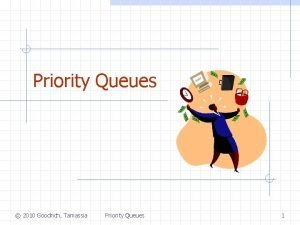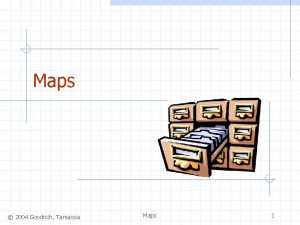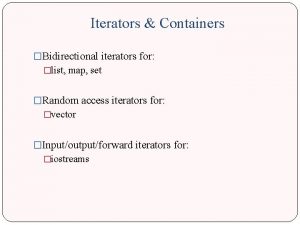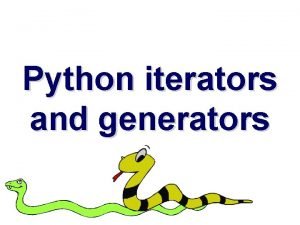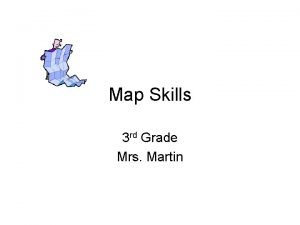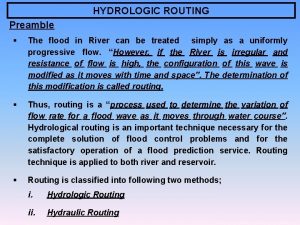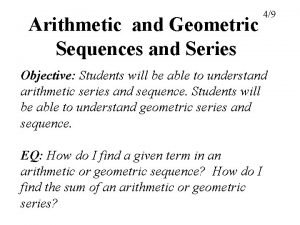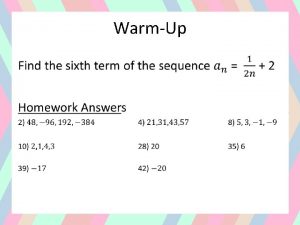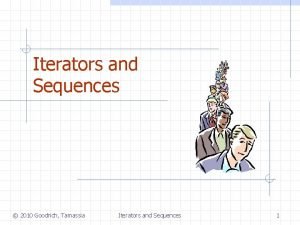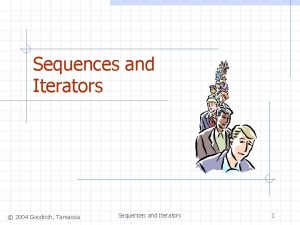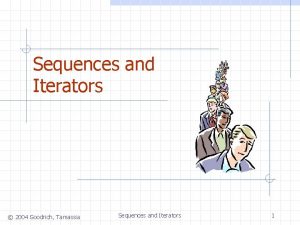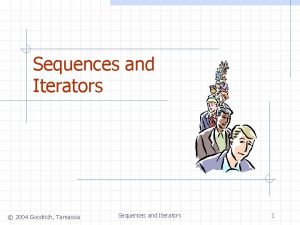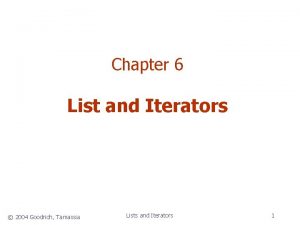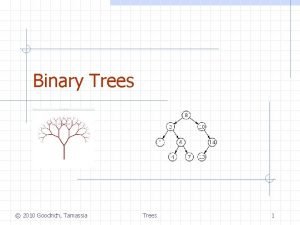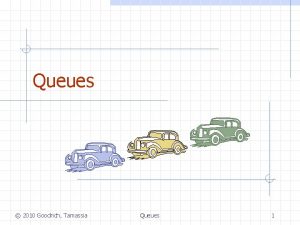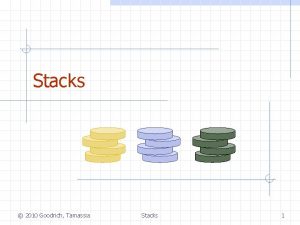Iterators and Sequences 2010 Goodrich Tamassia Iterators and











- Slides: 11

Iterators and Sequences © 2010 Goodrich, Tamassia Iterators and Sequences 1

Iterators q q q An iterator abstracts the process of scanning through a collection of elements It maintains a cursor that sits between elements in the list, or before the first or after the last element Methods of the Iterator ADT: n n q q has. Next(): returns true so long as the list is not empty and the cursor is not after the last element next(): returns the next element Extends the concept of position by adding a traversal capability Implementation with an array or singly linked list © 2010 Goodrich, Tamassia Iterators and Sequences 2

Iterable Classes q q An iterator is typically associated with an another data structure, which can implement the Iterable ADT We can augment the Stack, Queue, Vector, List and Sequence ADTs with method: n n q Iterator<E> iterator(): returns an iterator over the elements In Java, classes with this method extend Iterable<E> Two notions of iterator: n n n snapshot: freezes the contents of the data structure at a given time dynamic: follows changes to the data structure In Java: an iterator will fail (and throw an exception) if the underlying collection changes unexpectedly © 2010 Goodrich, Tamassia Iterators and Sequences 3

The For-Each Loop q Java provides a simple way of looping through the elements of an Iterable class: n n for (type name: expression) loop_body For example: List<Integer> values; int sum=0 for (Integer i : values) sum += i; // boxing/unboxing allows this © 2010 Goodrich, Tamassia Iterators and Sequences 4

Implementing Iterators q Array based n n q Linked list based n n q array A of the elements index i that keeps track of the cursor doubly-linked list L storing the elements, with sentinels for header and trailer pointer p to node containing the last element returned (or the header if this is a new iterator). We can add methods to our ADTs that return iterable objects, so that we can use the for-each loop on their contents © 2010 Goodrich, Tamassia Iterators and Sequences 5

List Iterators in Java q q Java uses a the List. Iterator ADT for node-based lists. This iterator includes the following methods: n n n n add(e): add e at the current cursor position has. Next(): true if there is an element after the cursor has. Previous: true if there is an element before the cursor previous(): return the element e before the cursor and move cursor to before e next(): return the element e after the cursor and move cursor to after e set(e): replace the element returned by last next or previous operation with e remove(): remove the element returned by the last next or previous method © 2010 Goodrich, Tamassia Iterators and Sequences 6

Sequence ADT q q The Sequence ADT is the union of the Array List and Node List ADTs Elements accessed by n n q q List-based methods: n Index, or Position Generic methods: n q size(), is. Empty() q first(), last(), prev(p), next(p), replace(p, o), add. Before(p, o), add. After(p, o), add. First(o), add. Last(o), remove(p) Bridge methods: n at. Index(i), index. Of(p) Array. List-based methods: n get(i), set(i, o), add(i, o), remove(i) © 2010 Goodrich, Tamassia Iterators and Sequences 7

Applications of Sequences q q The Sequence ADT is a basic, generalpurpose, data structure for storing an ordered collection of elements Direct applications: n n q Generic replacement for stack, queue, vector, or list small database (e. g. , address book) Indirect applications: n Building block of more complex data structures © 2010 Goodrich, Tamassia Iterators and Sequences 8

Linked List Implementation q q A doubly linked list provides a reasonable implementation of the Sequence ADT Nodes implement Position and store: n n n q element link to the previous node link to the next node q q Position-based methods run in constant time Index-based methods require searching from header or trailer while keeping track of indices; hence, run in linear time Special trailer and header nodes/positions header trailer elements © 2010 Goodrich, Tamassia Iterators and Sequences 9

Array-based Implementation q q n n q elements We use a circular array storing positions A position object stores: Element Index Indices f and l keep track of first and last positions 0 1 3 positions S f © 2010 Goodrich, Tamassia 2 Iterators and Sequences l 10

Comparing Sequence Implementations Operation size, is. Empty at. Index, index. Of, get first, last, prev, next Array 1 1 1 List 1 n 1 set(p, e) set(i, e) add, remove(i) add. First, add. Last add. After, add. Before remove(p) 1 1 n n 1 1 1 © 2010 Goodrich, Tamassia Iterators and Sequences 11
 Goodrich tamassia
Goodrich tamassia Goodrich tamassia
Goodrich tamassia Maps and sets support bidirectional iterators.
Maps and sets support bidirectional iterators. Yield vs return python
Yield vs return python Laura tamassia
Laura tamassia North south east west direction
North south east west direction Reservoir routing example
Reservoir routing example Heidi goodrich andrade
Heidi goodrich andrade Jamal goodrich
Jamal goodrich Flood routing example
Flood routing example Arithmetic and geometric sequences and series
Arithmetic and geometric sequences and series 10-2 arithmetic sequences and series
10-2 arithmetic sequences and series
